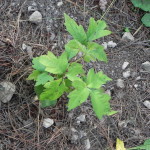Few plants cause as much human misery as poison ivy. Direct contact with the allergenic oil on its leaves or in its roots or stems can cause itchy welts in people.
Poison ivy is as tricky as it is common. Most outdoor people know to avoid it when it’s growing rapidly in spring but forget about it the rest of the year. We’ve gotten a poison ivy rash in nearly every month and most commonly get a good case in late spring when we’re working in the yard and garden. The plant is sappy then and when we’ve inadvertently pulled the roots out of the ground without wearing gloves we’ve gotten rashes. But late summer into fall are also prime times to get poison ivy rash. Birds eat the seeds which they drop in excrement and the new plants take hold in summer’s lushness. Gardeners encounter the new plants during deep-season weeding or fall “tuck-in” time.
Poison ivy is common in urban and rural areas. It is highly adaptable, preferring light shade, but also thriving in full sun and dense shade. Usually it hugs the ground, but it can grow to a shrub six feet tall or a vine that climbs to the top of trees. It likes to hide inside the greenery of urban hedges. Poison ivy usually has three leaves and is often confused with five-leafed Virginia creeper.
Humans must come in physical contact with the plant or its oil (urushiol) to end up itching. Inhaling smoke laced with poison ivy is asking for trouble. People generally contract poison ivy from tools, pets, farm animals and clothes that have contacted the plant. Any season is game. The Centers for Disease Control and Prevention has an excellent page on range of the plant and its cousin poison oak as well as poison sumac, symptoms, prevention, and care of tools that have been used in extricating poison ivy. Avoiding contact is the best way to prevent a rash. If bare skin comes in contact with the plant immediately wash the area with plenty of soap and warm water.
Despite the misery it causes humans, poison ivy is valuable to wildlife. Deer and cottontails readily eat it, especially in the winter. Birds devour the seeds helping to spread it around in their droppings. Birds like to perch on small end branches of trees so, we’ve learned to look up and assess the likelihood of contacting poison ivy shoots before plunging into a weedy flower bed.
The plant has another merit. Its leaves are one of the first to turn color in early fall, often to a brilliant red. Spot a patch of bright red leaves close to the ground in September and chances are they are either poison ivy or nonpoisonous smooth sumac.


